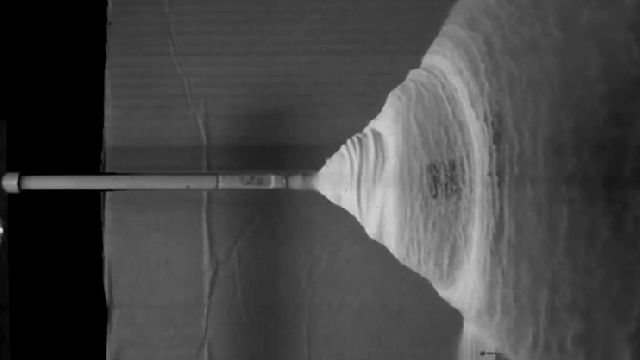A machine shoots a blast of beads at a metal target. The result is a beautiful conical structure known as a “water bell”. It’s significant because one kind of substance (granular material) changes its behaviour to act like another substance entirely — and the universe has seen this kind of change before.
Th water bell doesn’t behave exactly like a bell made of liquid should. As the bell gets wider, the “bell” breaks apart. A water bell would stay together, because of surface tension — the cohesive force between water molecules. The glass beads don’t feel any attraction to each other, the way that water molecules do, so they spread outward instead.
So why do they act like water molecules at all? Why do they behave like a liquid in the beginning of the video? The metal bar essentially mirrors the stream of beads, sending it right back where it came from. According to a 2007 paper by physicists at the University of Chicago describing the phenomenon, “Inside the interaction region, particles undergo rapid collisions and are confined by pressure from the incoming jets on both sides. The only way in which particles can escape (which they must since new particles are entering the region continuously) is to emerge perpendicularly to the jet axis.”
Translation: there are a high number of collisions, and the constant stream of particles pressing in from behind causes those in front to make room for the incoming particles by squirting out sideways at a slight angle, much like water would, forming that striking bell shape.
The same kind of behaviour is also produced by the heavy-ion shooters over at the Relativistic Heavy Ion Collider. RHIC shoots heavy ions at each other in order to create a quark-gluon plasma and study its behaviour. Before the universe got around to inventing these new-fangled things called “protons”, there was merely a free-moving mix of quarks (the stuff that makes protons) and gluons (the stuff that forces quarks together to make protons).
That is a quark-gluon plasma, and it may have exhibited the same kind of scattering pattern as the glass beads in the video. When the density of matter goes up enough, and the collisions become frequent enough, the plasma goes through a type of phase transition and behaves the way a liquid does.
This tells us something about what the first moments of the universe were like. The beads are under the constraints of classical physics, and the quarks and gluons are not. But when we see these single particles form a “water bell” as if they were a liquid, we’re seeing an analogue of what happened in the millionths of a second after the Big Bang.
[Source: Collective Behaviour in a Granular Jet: Emergence of a Liquid with Zero Surface Tension, Nagel Group: Granular Materials]
